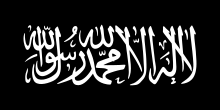Black banner



The Black Banner ( Arabic الراية السوداء, DMG ar-rāya as-sawdāʾ ; alsoراية العُقَاب / rāyat al-ʿuqāb ) is a flag used by many Islamist terrorist organizations such as al-Qaeda and the Islamic State organization .
Historical use
According to tradition , Ali is said to have wielded a white flag of the Prophet at the Battle of Siffin , while the opposing troops of Muʿāwiya were recognizable by black banners.
According to Hadith tradition, Mohammed said that the arrival of the Mahdi was signaled by the black banner coming from the Fitna ( times of apostasy ) by Abū Nuʿaim , a Sunni legal scholar, and by Ahwal from Safarini from the Khorasan .
The white, Arabic-written Shahāda (the creed in Islam) on a black background goes back to a Pashtun tradition, more precisely to a rebellion by Mir Wais Hotak , the founder of the Hotaki dynasty in the 18th century. The black banner symbolizes Tawheed ( belief in the unity and unity of God ) and Jihad .
Jihadists black banner
This black banner of the Hotaki dynasty was later adopted by the Taliban , then by al-Qaida and finally by the so-called Islamic State (ISIS, IS since 2014). It is also found in the al-Shabaab militia and the Union of Islamic Courts . In the upper part is the first part of the Creedلا إله إلا الله / Lā ilāha illā ʾllāh / 'There is no god but God'. In the lower part the seal of the prophet is depicted, the text corresponds to the second part of the creed to be read from bottom to top,محمد رسول الله / Muḥammadun rasūlu ʾllāh / 'Mohammed is the Messenger of God'. Due to the prohibition of IS in Germany, the use of its black banner as a mark of an unconstitutional organization is also punishable in accordance with Section 86a of the Criminal Code.
See also
Individual evidence
- ^ Martin Hinds: Studies in Early Islamic History . Darwin Press, 1996, ISBN 978-0-87850-109-0 , p. 109.
- ^ David Cook : Studies in Muslim Apocalyptic . Darwin Press, 2002, pp. 153,125,206. It should be noted that this particular tradition is ambiguous and whether the Mahdi himself would choose the black flag. Other traditions are less prudent.
Web links
- Christoph Sydow: The IS banner: Power of the black flag. Spiegel Online (October 7, 2014, accessed July 28, 2016)